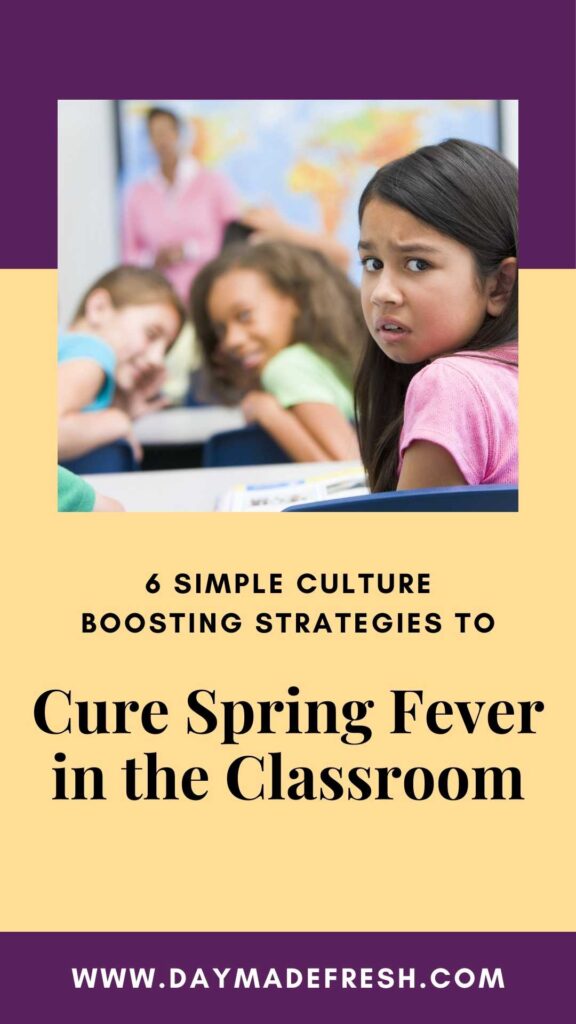Spring Fever has a way of blooming in classrooms this time of year. Students get restless, boundaries get tested, and the energy can feel just a little… off. No wonder we start counting the days until Spring Break—or even Summer. But here’s the good news: you can reset and finish strong with the right strategies.
The good news? You can reset your classroom culture. It may take a few tries to find the right strategies for your current classroom of students, but you can end the school year on a high note.
Spring Fever in the Classroom? Try these Simple Culture-Boosting Strategies

When finding a cure for spring fever, you need to address the symptoms. Start by identifying the key components that negatively impact your classroom (and your sanity). Are you dealing with students who are less focused or not completing work? Is the issue student peer relationships—bullying, cliques, etc.? Have students become disrespectful or been pushing boundaries? It might be a combination of issues. Pick one to focus on and choose one strategy to try with students.
This post contains some affiliate links for your convenience. Click here to read my full disclosure policy.
Classroom Reboot
Sometimes you need to do a classroom reboot. These two strategies are great options to try first.
1. Review and Reinforce Classroom Expectations
If you’re returning from Spring Break or even on Mondays, it can be a great use of time to revisit your classroom expectations. Discuss your classroom rules, provide students with clear guidelines, and remind them that the rules are to help everyone have a positive learning experience. If you have a class mission statement or contract that you co-wrote with your students, you can review it with your students. Then lead a discussion about whether, as a class, you are holding to the commitment you all made.
Haven’t made a class mission statement yet? It’s not too late! My Class Mission Statement Worksheets guide you through creating a shared classroom vision that builds community and helps reset behavior expectations meaningfully.
Want a simple, stress-free way to review expectations after Spring Break (or even on a Monday)? Grab my free printable review routine to walk your class through the process step-by-step. It’s a quick, meaningful way to refocus the class and get back on track—without starting from scratch.
Related Blog Post: 7 Steps to a Class Mission Statement
2. Hold Morning Meetings
Quick morning meetings can also re-establish a positive classroom culture and learning environment. You can use these to review your expectations, discuss classroom issues, set daily goals, or do quick team-building activities.
During COVID virtual learning, I fully understood the importance of morning meetings and time for students to settle in, talk, and share with one another. This shouldn’t take a lot of time. If you hold the meetings with a clear purpose, they can positively affect the rest of the school day and allow for a smoother day.
Morning meetings are one of my favorite ways to reset the day’s tone. Check out my Morning Meeting Slides if you want a simple, consistent way to run them. They include daily prompts, expectations reminders, and team-building activities—all ready to go, so you can focus on connecting with your students.
Embrace the Spring Fever in the Classroom
Spring Fever can often cause students to be less focused, busier, chattier, etc. After a long winter cooped up inside, teachers feel the same way. This is when providing an outlet for the energy can be beneficial. It doesn’t take away from learning because the negative, off-task behaviors would be taking time away if you didn’t take a break.
3. Incorporate Brain Breaks
If students aren’t focused because their bodies are dysregulated, continuing to teach is a waste of time. Instead, provide short breaks that allow students to release pent-up energy and reengage in learning.
One of my favorite tools for Brain Breaks is GoNoodle. When I taught kindergarten in 2012, GoNoodle didn’t yet exist. Instead, I used CDs or YouTube videos of movement breaks. When GoNoodle came out, it was a game-changer and has just gotten better!
4. Engage in Outdoor Learning
If possible, take your lessons outside. This allows students and you to enjoy the warmer weather and provides a change of scenery, which can make learning more engaging.
When planning your yearly schedule, identify units or topics that lend themselves to outdoor learning and plan them for when the weather cooperates. For example, in third grade, I taught a conservation unit. This integrated science, social studies, and writing unit had students go to our community to identify an environmental problem. We went outside to observe the community and took a short hike to a local pond and river affected by an oil spill and other pollution.
Even if your curriculum doesn’t lend itself to outdoor learning, you can stave off Spring Fever by taking kids outside to do other activities. Reading and writing outdoors can be relaxing or calming for stressed or overstimulated students. At the same time, a game can help students work on team building and get some movement.
No matter what you choose to do outside with students. Take the time to set expectations for outside learning to differentiate it from recess/free choice time.
Target Individual Student Spring Fever
Sometimes, it’s not your entire class that has come down with Spring Fever in your classroom. Other times, you may be trying to keep Spring Fever from spreading. In this case, taking a more targeted approach and focusing on individual behaviors can be better.
5. Secret Student
This strategy can be used throughout the year but is a great tool to pull out when Spring Fever tries to derail classroom behavior. Explain to students that each morning, you will pick a student and observe them throughout the day. If they meet expectations and demonstrate leadership, they earn a small reward.
The key is to keep it a mystery so all students think they might be the ones being watched. The goal is to rotate through all students but focus on the students who need the most positive reinforcement. Depending on how your day is organized, you could use the same concept to have a secret table group or even a secret class if you see multiple classes daily.
6. Positive Communication Home
This is another excellent year-round strategy that can easily be overlooked as we get to the end of the school year. A quick note, email, or phone call home can strengthen school-home connections, build student buy-in, and reinforce positive behaviors.
The key to impactful communication home is being specific about what the student is being recognized for.
| Generic | Specific |
| Annie had a great day! | Annie was a leader today when she talked her group through solving some math word problems! |
| Andy is a great student! | Andy worked hard on his math test today. Even when it was challenging, he stuck with it and showed persistence. |
| Nice Job, Betty! | Betty, I’m so proud of all the work you did on your presentation. I can tell that you practiced, because you spoke so clearly and were comfortable speaking in front of the class. |
This strategy, while beneficial, can also take a lot of extra time and effort on your part as the teacher. You don’t need to do each student every day. Instead, schedule one student per day. Then keep track of who you’ve recognized and work through it with each student. It can help to start with the students who might need multiple days to demonstrate something to communicate positively.
Spring Fever is real, but you mustn’t ride it alone. Try one strategy, see how it works, and build from there. I’d love to hear what you try—drop a comment below or share your favorite Spring Fever tip! Together, we can make the last stretch of the year a great one.
Helpful Tools for Tackling Spring Fever:
- Free Expectations Review Printable – Easy, structured way to reset expectations
- Class Mission Statement Worksheets – Co-create a classroom vision and commitment
- Morning Meeting Slides – Daily prompts and structure for meaningful connections
- How to Create a Strong Classroom Management Plan– Post about creating a classroom management plan.
